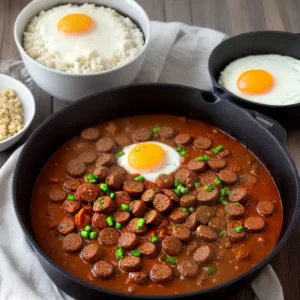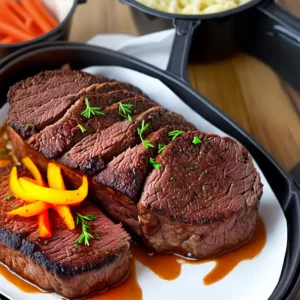Reheating fried chicken can be a challenge, as you want to retain its crispy coating and moist meat. Microwaving is not recommended as it results in a soggy mess. The best methods involve using the oven, air fryer, or stovetop to reheat the chicken while keeping it crispy and juicy.
Key Takeaways:
- Reheating fried chicken in the oven, air fryer, or stovetop is the best way to maintain its crispy coating and moist meat.
- Microwaving fried chicken leads to a soggy texture and loss of flavor.
- The oven method involves preheating to 400 degrees Fahrenheit and baking for 15 minutes, while the air fryer method requires preheating to 375 degrees Fahrenheit and cooking for 4 minutes.
- The stovetop method uses a skillet with oil heated to 300 degrees Fahrenheit to quickly achieve a crispy result.
- Defrosting frozen fried chicken in the microwave before reheating in the oven or air fryer ensures thorough heating.
Why Microwaving is Not Recommended for Reheating Fried Chicken
When it comes to reheating fried chicken, using the microwave may seem like a quick and convenient option. However, microwaving fried chicken can lead to a soggy, unappetizing mess. The microwave does not allow the chicken to maintain its crispy skin and can result in a loss of flavor and texture.
One of the reasons why microwaving is not recommended for reheating fried chicken is because it doesn’t provide the even heat distribution needed to keep the crispy coating intact. The high heat from the microwave causes the moisture in the chicken to turn into steam, making the skin moist and soft instead of crispy. Additionally, the microwave can also lead to uneven reheating, with some parts of the chicken becoming rubbery while others remain cold.
To ensure that your reheated fried chicken is crispy and delicious, it’s best to avoid using the microwave altogether. Instead, opt for methods such as the oven, air fryer, or stovetop, which allow for more controlled heating and better results.
Why Microwaving is Not Recommended for Reheating Fried Chicken
“The microwave does not allow the chicken to maintain its crispy skin and can result in a loss of flavor and texture.”
| Method | Pros | Cons |
|---|---|---|
| Oven | Retains crispy skin and moist meat. | Takes longer than other methods. |
| Air Fryer | Results in crispy chicken with less oil. | Requires an air fryer appliance. |
| Stovetop | Quick and yields crispy results. | Uses more oil than other methods. |
The Oven Method for Reheating Fried Chicken
When it comes to reheating fried chicken, the oven method is a tried and true technique that ensures both crispiness and moisture. To begin, preheat your oven to 400 degrees Fahrenheit. While the oven is warming up, place the chicken on a wire rack on top of a baking sheet. This setup allows for proper air circulation and even heating.
Once the oven is ready, place the baking sheet with the chicken on the middle rack. Let it bake for approximately 15 minutes, or until the skin becomes hot and crispy. Keep a close eye on the chicken to avoid overcooking. The high temperature of the oven will help revive the crunchiness of the coating while keeping the meat moist and tender.
The oven method provides a consistent reheat for your fried chicken, ensuring that all parts of the chicken are evenly heated. It also allows the flavors to meld together, resulting in a deliciously satisfying bite. Whether you’re reheating a single piece or a whole batch, the oven method is a reliable choice that guarantees crispy and moist fried chicken every time.
Table: Comparing Different Reheating Methods for Fried Chicken
| Reheating Method | Crispiness | Moisture | Temperature |
|---|---|---|---|
| Oven | Crispy | Moist | 400°F |
| Air Fryer | Crispy | Moist | 375°F |
| Stovetop | Crispy | Moist | 300°F |
| Foil-Wrapped Oven | Juicy | N/A | 350°F |
The Air Fryer Method for Reheating Fried Chicken
When it comes to reheating fried chicken, the air fryer can be a game-changer. Not only does it provide a quick and efficient way to warm up your leftovers, but it also helps maintain the crispy texture that makes fried chicken so enjoyable. With the right temperature and timing, you can achieve a perfectly reheated piece of chicken that is both crispy and moist.
Using an air fryer for reheating fried chicken is simple. Preheat the air fryer to 375 degrees Fahrenheit, then place the chicken pieces in a single layer in the basket. The hot air circulates around the chicken, creating a crispy exterior while keeping the meat juicy on the inside. Remember to flip the chicken once during the cooking process to ensure even heating.
The air fryer method is particularly great for those who are conscious of their oil intake. Unlike traditional frying methods, the air fryer requires little to no additional oil, yet still delivers that satisfying crunch. Whether you’re reheating drumsticks, wings, or chicken tenders, the air fryer will help you achieve that perfect balance of crispy and moist.
Benefits of the Air Fryer Method:
- Quick and efficient reheating
- Maintains crispy skin without additional oil
- Retains moisture in the meat
- Easy to use and clean
So, if you’re looking for a hassle-free way to reheat your fried chicken while preserving its crispy exterior and juicy interior, give the air fryer method a try. You’ll be able to enjoy that delicious, restaurant-quality taste from the comfort of your own home.
The Stovetop Method for Reheating Fried Chicken
When it comes to reheating fried chicken, the stovetop method is an excellent option. This method allows you to achieve a crispy exterior while keeping the meat inside moist and tender. To start, heat a skillet with a neutral oil, such as canola, to 300 degrees Fahrenheit. The oil temperature is crucial for ensuring that the chicken cooks evenly and stays crispy.
Carefully place the chicken pieces in the hot oil, being mindful not to overcrowd the skillet. Overcrowding can lead to uneven cooking and a loss of crispiness. Cook the chicken for about 2 to 3 minutes on each side, or until the coating becomes golden brown and crispy. The high heat of the stovetop ensures that the chicken reheats quickly, resulting in a delicious meal in no time.
This method does require extra oil compared to other reheating methods, but it is well worth it for the perfectly crisp and moist chicken you’ll enjoy. The hot oil seals in the moisture, preventing the meat from drying out during reheating. The result is a flavorful and satisfying meal that rivals freshly made fried chicken.
Best Practices for the Stovetop Method
- Use a skillet with high sides to prevent oil splatters.
- Ensure that the oil reaches the desired temperature of 300 degrees Fahrenheit before adding the chicken.
- Do not overcrowd the skillet to maintain even cooking and crispiness.
- Monitor the cooking time closely to avoid overcooking the chicken.
- Place the cooked chicken on a wire rack to allow excess oil to drain off.
| Pros | Cons |
|---|---|
| Quick reheating time | Requires extra oil |
| Retains crispy exterior | Potential for oil splatters |
| Moist and flavorful meat | Requires careful monitoring of cooking time |
The stovetop method for reheating fried chicken is a fantastic option when you’re looking to enjoy the crispy and moist goodness of this popular dish. With a little bit of care and attention, you can savor the same delicious flavors and textures as when the chicken was freshly cooked. So fire up your stove and indulge in some crispy, mouthwatering reheated fried chicken!
The Foil-Wrapped Oven Method for Reheating Fried Chicken
If you prefer a juicier result when reheating your fried chicken, the foil-wrapped oven method can be a great option. By wrapping the chicken in foil before placing it in a preheated oven, you can lock in the moisture and prevent the chicken from drying out while reheating.
To use this method, simply wrap each piece of fried chicken tightly in foil. Make sure to seal the edges to trap the steam inside. Then, place the wrapped chicken in a preheated oven set to 350 degrees Fahrenheit.
Allow the chicken to heat for a few minutes, checking periodically, until it reaches the desired temperature. This method helps to maintain the juiciness of the chicken while ensuring that it is thoroughly reheated and ready to enjoy.
Remember, when using the foil-wrapped oven method, it’s important not to leave the chicken in the oven for too long, as it can cause the chicken to overcook or dry out. Keep a close eye on the chicken to ensure it reaches the perfect level of juiciness without sacrificing its crispy coating.
| Method | Temperature | Cooking Time | Result |
|---|---|---|---|
| Oven | 350°F | A few minutes | Juicy, evenly reheated |
| Air Fryer | 375°F | About 4 minutes | Crispy, moist |
| Stovetop | 300°F | 2-3 minutes per side | Deliciously crispy |
Tips for Reheating Fried Chicken
When it comes to reheating fried chicken, following a few simple tips and tricks can make a big difference in preserving its flavor and texture. Here are some helpful suggestions to ensure the best results:
- Bring the chicken to room temperature: Allowing the chicken to come to room temperature before reheating helps it cook more evenly. This ensures that all parts of the chicken are heated thoroughly and prevents overcooking or undercooking.
- Avoid overcrowding the cooking vessel: Whether you’re using the oven, air fryer, or stovetop, make sure not to overcrowd the pan or tray. This allows for proper airflow and ensures that the chicken cooks evenly and becomes crispy.
- Adjust cooking time based on size: The size of the chicken pieces will impact the reheating time. Larger pieces may require a few extra minutes in the oven or air fryer, while smaller pieces may need less time. Keep an eye on the chicken to prevent any overcooking.
By following these tips, you can maintain the flavor and texture of your fried chicken when reheating. Whether you prefer the oven, air fryer, or stovetop method, these suggestions will help you achieve crispy and moist results every time.
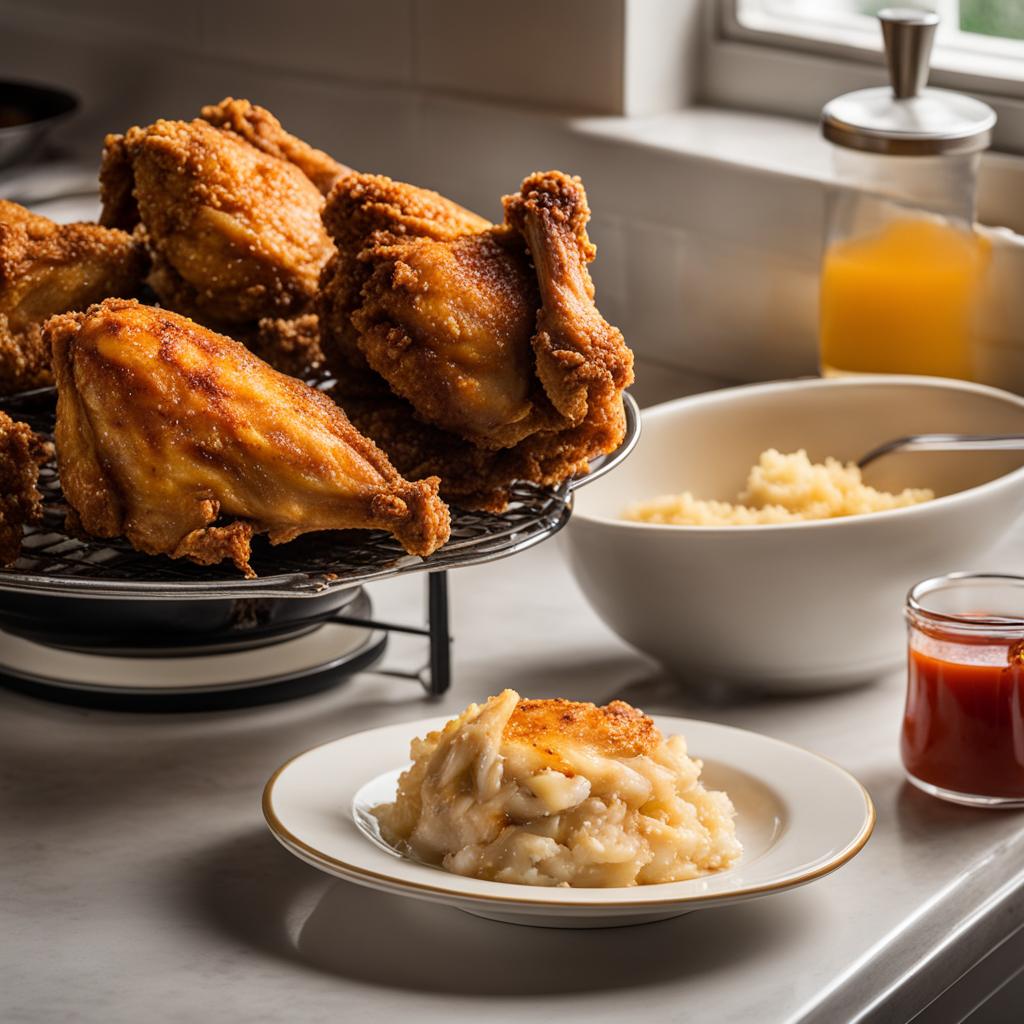
The Importance of Room Temperature for Reheating Fried Chicken
When it comes to reheating fried chicken, ensuring that the chicken is at room temperature before starting the reheating process is crucial. Allowing the chicken to come to room temperature helps promote even cooking throughout, resulting in a consistently delicious and flavorful outcome.
Reheating cold chicken straight from the refrigerator can lead to uneven cooking, with the exterior becoming overcooked while the interior remains cool. By bringing the chicken to room temperature, it allows the heat to penetrate evenly, ensuring that each bite is warm and succulent.
One way to bring the chicken to room temperature is by taking it out of the refrigerator and letting it sit on the counter for about 30 minutes before reheating. This simple step can make a significant difference in the final result.
So, the next time you want to enjoy leftover fried chicken, remember to let it come to room temperature before reheating. Your taste buds will thank you!
Table: The Benefits of Room Temperature for Reheating Fried Chicken
| Benefits | Explanation |
|---|---|
| Even Cooking | Room temperature chicken ensures even heat distribution and avoids overcooking or undercooking. |
| Improved Flavor | Allowing the chicken to come to room temperature amplifies its natural flavors. |
| Consistent Texture | Room temperature chicken reheats consistently, preventing dry or rubbery texture. |
| Reduced Cooking Time | Starting with room temperature chicken reduces the overall reheating time. |
The Role of a Wire Rack in Reheating Fried Chicken
When it comes to reheating fried chicken, using a wire rack can play a vital role in achieving that perfect crispy texture. Placing the chicken on a wire rack allows for better airflow, ensuring that every part of the chicken gets evenly heated. This means that you’ll be able to enjoy that satisfying crunch with each bite, whether it’s the drumstick, breast, or wing.
The wire rack also helps to prevent the chicken from sitting in its own juices, which can result in a soggy and less appetizing coating. By elevating the chicken off the baking sheet, the excess moisture is able to drip down, keeping the bottom of the chicken crispy. This ensures that every piece of fried chicken you reheat maintains its delicious crunch.
Not only does the wire rack promote even heating and prevent sogginess, but it also allows for easy cleanup. Any excess oil or drippings from the chicken are collected on the baking sheet below, making it simple to dispose of or reuse. So not only does using a wire rack enhance the taste and texture of your reheated fried chicken, but it also makes your post-meal cleanup a breeze.
| Benefits of Using a Wire Rack for Reheating Fried Chicken: |
|---|
| 1. Evenly heats every part of the chicken |
| 2. Prevents the chicken from sitting in its own juices |
| 3. Maintains a crispy coating on every piece |
| 4. Easy cleanup by collecting excess oil and drippings |
The Impact of Foil on Reheating Fried Chicken
When reheating fried chicken, many people are tempted to cover it with foil, thinking it will help prevent the chicken from drying out. However, using foil during the reheating process can actually have an unintended consequence – it can lead to soggy chicken skin. Let me explain why.
When you cover the chicken with foil, it traps the steam that is released during the reheating process. This trapped steam can’t escape, causing the moisture to get absorbed back into the chicken skin, resulting in a loss of crispiness. So, instead of getting that delicious, crispy coating you desire, you end up with a soggy mess.
To avoid this, it’s best to skip the foil and allow the chicken to crisp up naturally during the reheating process. By using methods such as the oven, air fryer, or stovetop, you can achieve a crispy exterior while maintaining the juicy, moist meat inside. These methods rely on hot air circulation and direct heat, which promote even cooking and help retain the desired texture of the fried chicken.
Why Foil is Not Recommended for Reheating Fried Chicken
“Covering fried chicken with foil traps steam, resulting in soggy skin and a loss of crispiness.”
So, the next time you are reheating fried chicken, remember to resist the urge to cover it with foil. Instead, choose a reheating method that allows for hot air circulation and direct heat. This will ensure that you achieve the crispy, flavorful results you desire without sacrificing the moisture of the chicken.
The Benefits of an Air Fryer for Reheating Fried Chicken
When it comes to reheating fried chicken, an air fryer can be a game-changer. Not only does it provide convenience, but it also delivers crispy skin without the need for additional oil. The hot circulating air in the air fryer ensures that every piece of chicken is evenly heated, resulting in a deliciously crispy coating that rivals freshly fried chicken.
One of the advantages of using an air fryer for reheating fried chicken is the ability to achieve a single layer of chicken. This is crucial for getting that perfect crunch on the skin. Placing the chicken in a single layer allows the hot air to circulate around each piece, ensuring even cooking and a consistent crispy texture.
With an air fryer, you can say goodbye to soggy reheated chicken. The use of rapid hot air circulation helps to remove excess moisture from the chicken, preventing it from becoming soggy during the reheating process. This means you can enjoy the same crispy skin and juicy meat that you love about freshly fried chicken, even when reheating leftovers.
The Benefits of an Air Fryer for Reheating Fried Chicken
- Delivers crispy skin without additional oil
- Ensures even cooking with a single layer
- Prevents the chicken from becoming soggy
Next time you have leftover fried chicken, consider using an air fryer for reheating. It provides the convenience of quick and even cooking, while also delivering that irresistible crispy skin. With an air fryer, you can enjoy the taste and texture of freshly fried chicken, even days after it was originally cooked.
The Advantages of the Stovetop Method for Reheating Fried Chicken
When it comes to reheating fried chicken, the stovetop method offers several advantages. Not only is it a quick way to warm up your leftovers, but it also results in a crispy coating that rivals the original dish. The high heat of the oil used on the stovetop ensures that the chicken remains crispy while reheating, giving you that satisfying crunch with every bite.
One of the key benefits of the stovetop method is its speed. Unlike the oven or air fryer, where preheating is required, you can start reheating your fried chicken on the stovetop right away. Simply heat a skillet with a neutral oil, such as canola, to around 300 degrees Fahrenheit, and carefully place the chicken in the hot oil. With just a few minutes on each side, you’ll have hot and crispy fried chicken ready to enjoy.
Another advantage of the stovetop method is the control you have over the heat. By adjusting the temperature of the oil, you can ensure that the chicken cooks evenly and doesn’t become too greasy. This allows you to achieve that perfect balance of crispy coating and moist meat, just like when the chicken was freshly fried.
Table: A Comparison of Reheating Methods for Fried Chicken
| Reheating Method | Advantages |
|---|---|
| Oven | – Even heating – Retains flavor and texture |
| Air Fryer | – Crispy skin without extra oil – Moist interior |
| Stovetop | – Quick and convenient – Crispy coating – Control over heat |
“The stovetop method is my go-to for reheating fried chicken. It’s fast, gives me that perfect crunch, and allows me to control the heat for even cooking. Plus, it’s so convenient when I’m craving some crispy chicken on short notice!” – Fried Chicken Lover
In conclusion, the stovetop method offers a quick and easy way to reheat fried chicken with a crispy coating. With control over the heat and a short cooking time, you can enjoy the same delicious crunch as when the chicken was first cooked. So why wait? Grab your skillet, heat up some oil, and indulge in some mouthwatering reheated fried chicken!
The Risks of Microwaving Fried Chicken
When it comes to reheating fried chicken, using a microwave may seem like a quick and convenient option. However, microwaving fried chicken can have detrimental effects on its texture and taste. The high heat and moisture from the microwave can cause the chicken to become soggy and rubbery, compromising its crispy coating and juicy meat.
Unlike other methods such as the oven, air fryer, or stovetop, which allow for even heating and the retention of moisture, microwaving fried chicken simply doesn’t produce the same desirable results. It’s not worth sacrificing the crispy, moist goodness of your favorite fried chicken for the sake of convenience.
Using a microwave to reheat fried chicken can result in a soggy mess. The chicken loses its crispy skin and becomes rubbery in texture. It’s best to avoid microwaving and opt for other methods that preserve the integrity of the chicken.
So, if you want to enjoy the same deliciousness of your fried chicken leftovers, it’s best to steer clear of the microwave. Choose alternative methods like the oven, air fryer, or stovetop, which will allow you to achieve crispy, moist reheated chicken without compromising its flavor and texture.
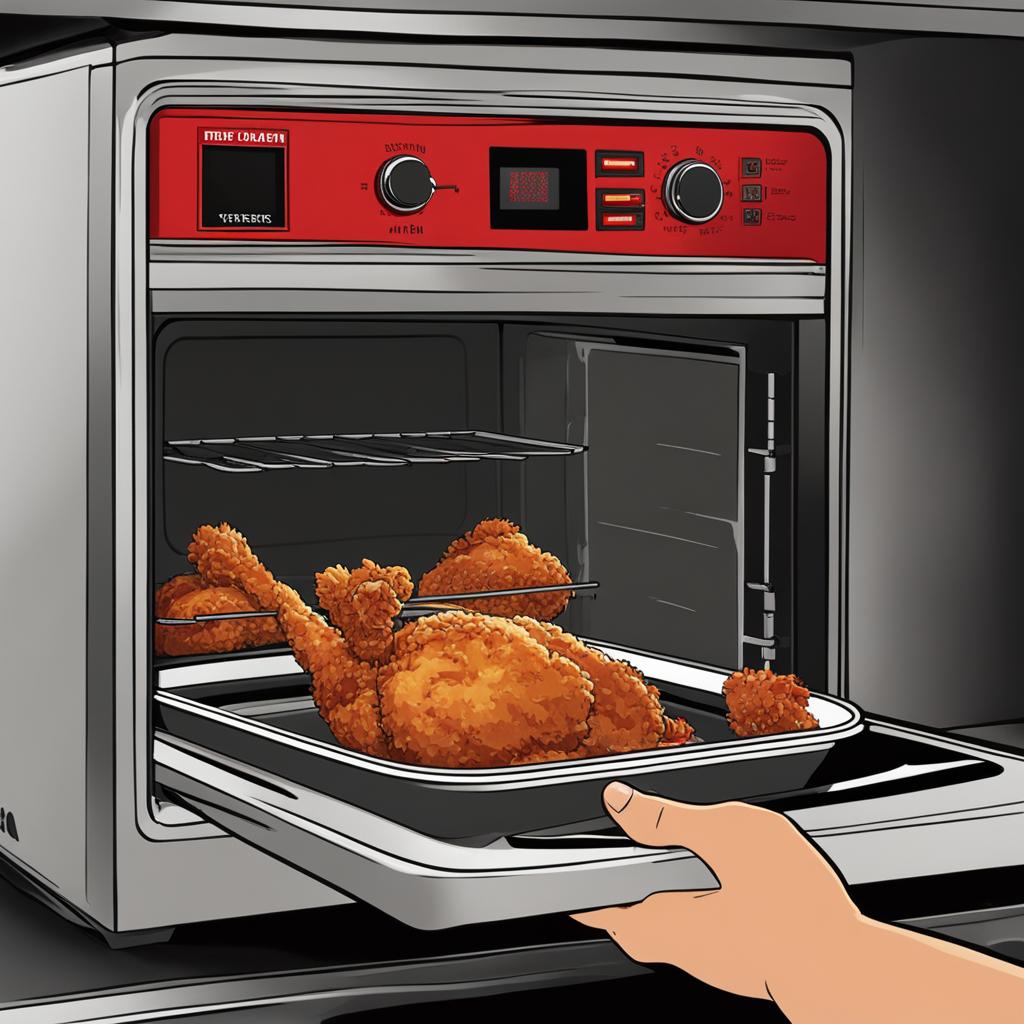
Remember, when it comes to reheating fried chicken, taking the time to use a method that preserves its crispy coating and juicy meat is well worth it. So, leave the microwave for warming up leftovers that aren’t as delicate as fried chicken, and opt for the oven, air fryer, or stovetop to ensure a satisfying and flavorful reheating experience.
The Freezing and Reheating of Fried Chicken
When it comes to enjoying leftover fried chicken, proper freezing and reheating techniques are essential. Freezing fried chicken allows you to preserve its flavor and texture for future meals. However, thawing and reheating must be done correctly to ensure that the chicken remains crispy on the outside and juicy on the inside.
First, when freezing fried chicken, it is important to wrap each piece individually in plastic wrap or aluminum foil. This prevents freezer burn and helps maintain the chicken’s moisture. It’s also a good idea to place the wrapped chicken in a freezer storage bag or airtight container to further protect it from freezer odors.
When it’s time to defrost the fried chicken, the recommended method is to use the microwave. Place the wrapped chicken on a microwave-safe plate and defrost on the lowest power setting, checking frequently to ensure it doesn’t start cooking. Once the chicken is thawed, it should be reheated immediately to avoid bacteria growth.
To achieve optimal results, finish reheating the defrosted chicken in either a preheated oven or air fryer. These methods will help restore the crispiness of the coating while ensuring that the chicken is heated all the way through. Set the oven or air fryer to the appropriate temperature, usually around 350 to 400 degrees Fahrenheit, and reheat the chicken for a few minutes until it is hot and crispy.
By following proper freezing, thawing, and reheating techniques, you can enjoy delicious and crispy fried chicken even after it has been frozen. Just remember to wrap the chicken well before freezing, defrost it safely, and use either the oven or air fryer to reheat it to perfection. With these tips, you can savor the flavors of your favorite fried chicken time and time again.
Conclusion
Reheating fried chicken can be a challenge, but with the right methods, you can enjoy crispy and moist results. Whether you choose to use the oven, air fryer, or stovetop, it’s important to follow proper reheating techniques to preserve the flavor and texture of the chicken. By bringing the chicken to room temperature, using a wire rack for even heating, and avoiding the use of foil, you can achieve crispy skin and deliciously moist meat.
While microwaving is not recommended for reheating fried chicken due to its tendency to result in soggy and rubbery texture, the oven method offers the best balance of crispiness and moisture. Preheating the oven to 400 degrees Fahrenheit and baking the chicken for about 15 minutes on a wire rack allows for thorough reheating while maintaining the crispy coating.
If you prefer a quicker option, an air fryer can provide crispy skin without the need for additional oil. Cooking the chicken in a single layer at 375 degrees Fahrenheit for about 4 minutes ensures even heating and delicious results. Alternatively, using the stovetop method with a skillet and neutral oil can yield quick and crispy reheated chicken.
Tips for Reheating Fried Chicken
- Bring the chicken to room temperature before reheating to ensure even cooking.
- Avoid overcrowding the cooking vessel to allow for proper airflow and prevent steaming.
- Adjust the cooking time based on the size of the chicken pieces to avoid overcooking.
By following these tips and considering personal preferences for crispiness and juiciness, you can enjoy delicious reheated fried chicken that rivals the original meal. So, don’t let those leftovers go to waste—reheat them properly and savor every crispy and moist bite!
Acknowledgments
I would like to express my gratitude to the various sources that have contributed to the information and tips provided in this article. The research conducted from reputable culinary experts and personal experience in the field has allowed me to compile a comprehensive guide on reheating fried chicken to achieve the perfect balance of crispiness and moisture.
The knowledge gained from these sources has highlighted the importance of using alternative methods such as the oven, air fryer, and stovetop to reheat fried chicken, as microwaving can result in a disappointing loss of texture and flavor. By following the recommendations presented, readers can savor the deliciousness of reheated fried chicken that retains its crispy coating and moist interior.
It is my hope that the insights shared in this article will empower individuals with the knowledge and skills to enjoy their leftover fried chicken in a way that maintains its original quality. With the combined efforts of the culinary community and personal experiences, achieving the perfect reheated fried chicken is now within reach for all.
FAQ
Why is microwaving not recommended for reheating fried chicken?
Microwaving fried chicken leads to a soggy and rubbery texture, resulting in a loss of crispiness and flavor.
What is the oven method for reheating fried chicken?
Preheat the oven to 400 degrees Fahrenheit, place the chicken on a wire rack on a baking sheet, and bake for about 15 minutes until the skin is hot and crispy.
How do I use an air fryer to reheat fried chicken?
Preheat the air fryer to 375 degrees Fahrenheit, place the chicken in a single layer, and cook for about 4 minutes, flipping once, to achieve crispy skin without additional oil.
What is the stovetop method for reheating fried chicken?
Heat a skillet with a neutral oil to 300 degrees Fahrenheit, carefully place the chicken in the oil, and cook for about 2 to 3 minutes on each side until it becomes crispy.
How can I use the foil-wrapped oven method to reheat fried chicken?
Wrap the chicken in foil and place it in a preheated oven at 350 degrees Fahrenheit for a few minutes to lock in moisture and prevent drying while reheating.
What are some tips for reheating fried chicken?
Tips include bringing the chicken to room temperature before reheating, avoiding overcrowding the cooking vessel, and adjusting cooking time based on the size of the chicken pieces.
Why is room temperature important for reheating fried chicken?
Allowing the chicken to come to room temperature before reheating ensures even cooking and prevents overcooking or undercooking of different parts of the chicken.
How does a wire rack help in reheating fried chicken?
Using a wire rack on a baking sheet allows for better airflow, ensuring even heating and a crispy coating on all parts of the chicken.
What is the impact of foil on reheating fried chicken?
Foil traps steam and can lead to soggy skin, so it’s best to skip the foil and allow the chicken to crisp naturally during reheating.
What are the benefits of using an air fryer for reheating fried chicken?
An air fryer allows for crispy skin without the need for additional oil, and arranging the chicken in a single layer ensures even cooking and a crispy coating on every piece.
What are the advantages of the stovetop method for reheating fried chicken?
The stovetop method is quick and results in a crispy coating, with the high heat of the oil ensuring the chicken remains crispy while reheating.
What are the risks of microwaving fried chicken?
Microwaving fried chicken results in a soggy and rubbery texture, ruining the crispy coating and flavor of the chicken.
How should I handle freezing and reheating fried chicken?
Defrost frozen fried chicken quickly in the microwave and finish reheating in a preheated oven or air fryer to ensure thorough heating and the maintenance of flavor and texture.
Source Links
- https://www.eatingwell.com/article/7965924/how-to-reheat-fried-chicken/
- https://www.foodnetwork.com/how-to/packages/food-network-essentials/make-leftover-fried-chicken-crisp
- https://www.thekitchn.com/how-to-reheat-fried-chicken-23312999
Related Recipes:
 How to Cook Air Fryer Potatoes? (Perfect Step-By-Step Guide)
How to Cook Air Fryer Potatoes? (Perfect Step-By-Step Guide)
 How to Reheat Fried Chicken: Keep It Crispy and Moist
How to Reheat Fried Chicken: Keep It Crispy and Moist
 Breville Smart Oven Air Fryer vs Pro: Which One to Choose
Breville Smart Oven Air Fryer vs Pro: Which One to Choose
 How to Air Fry Garlic? (Perfect Step-By-Step Guide)
How to Air Fry Garlic? (Perfect Step-By-Step Guide)
 How to Air Fry Any Vegetable? (Perfect Step-By-Step Guide)
How to Air Fry Any Vegetable? (Perfect Step-By-Step Guide)
 How to Reheat French Fries: Crispy Every Time
How to Reheat French Fries: Crispy Every Time
 How to Reheat Rotisserie Chicken Perfectly
How to Reheat Rotisserie Chicken Perfectly
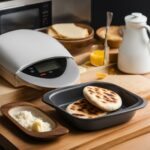 How to Reheat Naan Bread: Keep It Soft and Warm
How to Reheat Naan Bread: Keep It Soft and Warm


